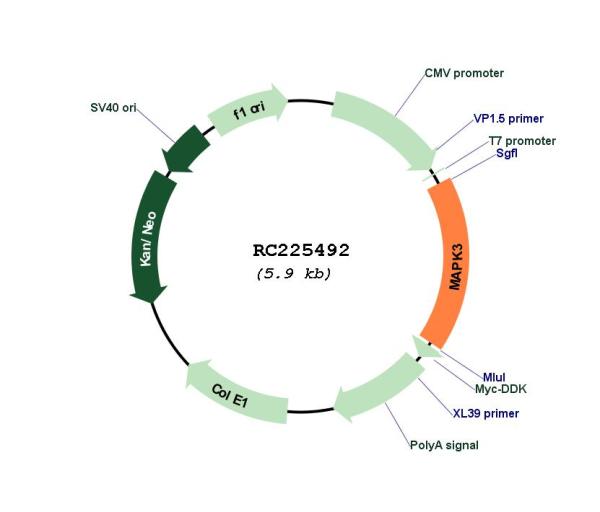ERK1 (MAPK3) (NM_001109891) Human Tagged ORF Clone
CAT#: RC225492
MAPK3 (Myc-DDK-tagged)-Human mitogen-activated protein kinase 3 (MAPK3), transcript variant 3
ORF Plasmid: tGFP
Lentiviral Particles: DDK w/ Puro mGFP w/ Puro
"NM_001109891" in other vectors (4)
USD 198.00
Specifications
| Product Data | |
| Type | Human Tagged ORF Clone |
| Tag | Myc-DDK |
| Symbol | ERK1 |
| Synonyms | ERK-1; ERK1; ERT2; HS44KDAP; HUMKER1A; p44-ERK1; p44-MAPK; P44ERK1; P44MAPK; PRKM3 |
| Vector | pCMV6-Entry |
| E. coli Selection | Kanamycin (25 ug/mL) |
| Mammalian Cell Selection | Neomycin |
| Sequence Data |
>RC225492 representing NM_001109891
Red=Cloning site Blue=ORF Green=Tags(s) TTTTGTAATACGACTCACTATAGGGCGGCCGGGAATTCGTCGACTGGATCCGGTACCGAGGAGATCTGCC GCCGCGATCGCC ATGGCGGCGGCGGCGGCTCAGGGGGGCGGGGGCGGGGAGCCCCGTAGAACCGAGGGGGTCGGCCCGGGGG TCCCGGGGGAGGTGGAGATGGTGAAGGGGCAGCCGTTCGACGTGGGCCCGCGCTACACGCAGTTGCAGTA CATCGGCGAGGGCGCGTACGGCATGGTCAGCTCGGCCTATGACCACGTGCGCAAGACTCGCGTGGCCATC AAGAAGATCAGCCCCTTCGAACATCAGACCTACTGCCAGCGCACGCTCCGGGAGATCCAGATCCTGCTGC GCTTCCGCCATGAGAATGTCATCGGCATCCGAGACATTCTGCGGGCGTCCACCCTGGAAGCCATGAGAGA TGTCTACATTGTGCAGGACCTGATGGAGACTGACCTGTACAAGTTGCTGAAAAGCCAGCAGCTGAGCAAT GACCATATCTGCTACTTCCTCTACCAGATCCTGCGGGGCCTCAAGTACATCCACTCCGCCAACGTGCTCC ACCGAGATCTAAAGCCCTCCAACCTGCTCATCAACACCACCTGCGACCTTAAGATTTGTGATTTCGGCCT GGCCCGGATTGCCGATCCTGAGCATGACCACACCGGCTTCCTGACGGAGTATGTGGCTACGCGCTGGTAC CGGGCCCCAGAGATCATGCTGAACTCCAAGGGCTATACCAAGTCCATCGACATCTGGTCTGTGGGCTGCA TTCTGGCTGAGATGCTCTCTAACCGGCCCATCTTCCCTGGCAAGCACTACCTGGATCAGCTCAACCACAT TCTGGCCCTTGACCTGCTGGACCGGATGTTAACCTTTAACCCCAATAAACGGATCACAGTGGAGGAAGCG CTGGCTCACCCCTACCTGGAGCAGTACTATGACCCGACGGATGAGCCAGTGGCCGAGGAGCCCTTCACCT TCGCCATGGAGCTGGATGACCTACCTAAGGAGCGGCTGAAGGAGCTCATCTTCCAGGAGACAGCACGCTT CCAGCCCGGAGTGCTGGAGGCCCCC ACGCGTACGCGGCCGCTCGAGCAGAAACTCATCTCAGAAGAGGATCTGGCAGCAAATGATATCCTGGATT ACAAGGATGACGACGATAAGGTTTAA >RC225492 representing NM_001109891
Red=Cloning site Green=Tags(s) MAAAAAQGGGGGEPRRTEGVGPGVPGEVEMVKGQPFDVGPRYTQLQYIGEGAYGMVSSAYDHVRKTRVAI KKISPFEHQTYCQRTLREIQILLRFRHENVIGIRDILRASTLEAMRDVYIVQDLMETDLYKLLKSQQLSN DHICYFLYQILRGLKYIHSANVLHRDLKPSNLLINTTCDLKICDFGLARIADPEHDHTGFLTEYVATRWY RAPEIMLNSKGYTKSIDIWSVGCILAEMLSNRPIFPGKHYLDQLNHILALDLLDRMLTFNPNKRITVEEA LAHPYLEQYYDPTDEPVAEEPFTFAMELDDLPKERLKELIFQETARFQPGVLEAP TRTRPLEQKLISEEDLAANDILDYKDDDDKV |
| Chromatograms |
CHROMATOGRAMS
 Sequencher program is needed, download here. |
| Restriction Sites |
SgfI-MluI
Cloning Scheme for this gene
Plasmid Map

|
| ACCN | NM_001109891 |
| ORF Size | 1005 bp |
| OTI Disclaimer | Due to the inherent nature of this plasmid, standard methods to replicate additional amounts of DNA in E. coli are highly likely to result in mutations and/or rearrangements. Therefore, OriGene does not guarantee the capability to replicate this plasmid DNA. Additional amounts of DNA can be purchased from OriGene with batch-specific, full-sequence verification at a reduced cost. Please contact our customer care team at custsupport@origene.com or by calling 301.340.3188 option 3 for pricing and delivery. The molecular sequence of this clone aligns with the gene accession number as a point of reference only. However, individual transcript sequences of the same gene can differ through naturally occurring variations (e.g. polymorphisms), each with its own valid existence. This clone is substantially in agreement with the reference, but a complete review of all prevailing variants is recommended prior to use. More info |
| OTI Annotation | This clone was engineered to express the complete ORF with an expression tag. Expression varies depending on the nature of the gene. |
| Product Components | The ORF clone is ion-exchange column purified and shipped in a 2D barcoded Matrix tube containing 10ug of transfection-ready, dried plasmid DNA (reconstitute with 100 ul of water). |
| Reconstitution | 1. Centrifuge at 5,000xg for 5min. 2. Carefully open the tube and add 100ul of sterile water to dissolve the DNA. 3. Close the tube and incubate for 10 minutes at room temperature. 4. Briefly vortex the tube and then do a quick spin (less than 5000xg) to concentrate the liquid at the bottom. 5. Store the suspended plasmid at -20°C. The DNA is stable for at least one year from date of shipping when stored at -20°C. |
| Reference Data | |
| RefSeq | NM_001109891.1, NP_001103361.1 |
| RefSeq ORF | 1008 bp |
| Locus ID | 5595 |
| UniProt ID | P27361 |
| Cytogenetics | 16p11.2 |
| Protein Families | Druggable Genome, ES Cell Differentiation/IPS, Protein Kinase |
| Protein Pathways | Acute myeloid leukemia, Adherens junction, Alzheimer's disease, Axon guidance, B cell receptor signaling pathway, Bladder cancer, Chemokine signaling pathway, Chronic myeloid leukemia, Colorectal cancer, Dorso-ventral axis formation, Endometrial cancer, ErbB signaling pathway, Fc epsilon RI signaling pathway, Fc gamma R-mediated phagocytosis, Focal adhesion, Gap junction, Glioma, GnRH signaling pathway, Insulin signaling pathway, Long-term depression, Long-term potentiation, MAPK signaling pathway, Melanogenesis, Melanoma, mTOR signaling pathway, Natural killer cell mediated cytotoxicity, Neurotrophin signaling pathway, NOD-like receptor signaling pathway, Non-small cell lung cancer, Oocyte meiosis, Pancreatic cancer, Pathways in cancer, Prion diseases, Progesterone-mediated oocyte maturation, Prostate cancer, Regulation of actin cytoskeleton, Renal cell carcinoma, T cell receptor signaling pathway, TGF-beta signaling pathway, Thyroid cancer, Toll-like receptor signaling pathway, Type II diabetes mellitus, Vascular smooth muscle contraction, VEGF signaling pathway |
| MW | 38.1 kDa |
| Gene Summary | The protein encoded by this gene is a member of the MAP kinase family. MAP kinases, also known as extracellular signal-regulated kinases (ERKs), act in a signaling cascade that regulates various cellular processes such as proliferation, differentiation, and cell cycle progression in response to a variety of extracellular signals. This kinase is activated by upstream kinases, resulting in its translocation to the nucleus where it phosphorylates nuclear targets. Alternatively spliced transcript variants encoding different protein isoforms have been described. [provided by RefSeq, Jul 2008] |
Documents
| Product Manuals |
| FAQs |
| SDS |
Resources
Other Versions
| SKU | Description | Size | Price |
|---|---|---|---|
| RC225492L3 | Lenti ORF clone of Human mitogen-activated protein kinase 3 (MAPK3), transcript variant 3, Myc-DDK-tagged |
USD 986.00 |
|
| RC225492L4 | Lenti ORF clone of Human mitogen-activated protein kinase 3 (MAPK3), transcript variant 3, mGFP tagged |
USD 986.00 |
|
| RG225492 | MAPK3 (tGFP-tagged) - Human mitogen-activated protein kinase 3 (MAPK3), transcript variant 3 |
USD 886.00 |
|
| SC317070 | MAPK3 (untagged)-Human mitogen-activated protein kinase 3 (MAPK3), transcript variant 3 |
USD 686.00 |
{0} Product Review(s)
Be the first one to submit a review






























































































































































































































































 Germany
Germany
 Japan
Japan
 United Kingdom
United Kingdom
 China
China




